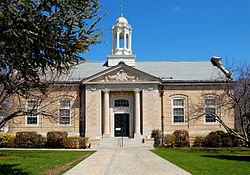Nahant, Massachusetts
| Nahant, Massachusetts | ||
|---|---|---|
| Town | ||

Town Hall of Nahant
|
||
|
||
 Location in Essex County and the state of Massachusetts. |
||
| Coordinates: 42°25′35″N 70°55′10″W / 42.42639°N 70.91944°WCoordinates: 42°25′35″N 70°55′10″W / 42.42639°N 70.91944°W | ||
| Country | United States | |
| State | Massachusetts | |
| County | Essex | |
| Settled | 1630 | |
| Incorporated | 1853 | |
| Government | ||
| • Type | Open town meeting | |
| • Town Administrator | Jeffrey Chelgren | |
| Area | ||
| • Total | 15.5 sq mi (40.1 km2) | |
| • Land | 1.0 sq mi (2.7 km2) | |
| • Water | 14.4 sq mi (37.4 km2) | |
| Elevation | 50 ft (15 m) | |
| Population (2010) | ||
| • Total | 3,410 | |
| • Density | 3,410.0/sq mi (1,316.6/km2) | |
| Time zone | Eastern (UTC-5) | |
| • Summer (DST) | Eastern (UTC-4) | |
| ZIP code | 01908 | |
| Area code(s) | 339 / 781 | |
| FIPS code | 25-43580 | |
| GNIS feature ID | 0618304 | |
| Website | www |
|
Nahant /nəˈhɑːnt/ is a town in Essex County, Massachusetts, United States. The population was 3,410 at the 2010 census. With just 1.0 square mile (2.7 km2) of land area, it is the smallest municipality by area in the state. It is primarily a residential community.
Native Americans called the area Nahant, meaning "the point" or "almost an island." The original Indian name of the place, Nahanten, signifies twins or two things united, referring to the two connected islands forming it. Located on a tied island jutting into Massachusetts Bay, it was first settled in 1630, in the second year of the Puritan coming. The servants of Isaac Johnson grazed his cattle on the land, and it was also often used by citizens of Lynn for grazing cattle, sheep and goats. Before 1800 there were only three homes on the island: those built by the Breeds and the Hoods, and the Johnson home built by Jeremiah Gray. The first hotel was built by one of the Johnsons 1802, and in 1817 a steamboat ran daily between Boston and Nahant. The town was originally part of Lynn; when the temperance movement threatened the summer resort trade in 1853, Nahant incorporated as a separate town. In the late 19th century, it was home to some of the country's first amusement parks, as well as a popular summer retreat for the wealthy, including the poet Henry Wadsworth Longfellow. The geologist Louis Agassiz was a resident and the artist William Stanley Haseltine produced many versions of his oil painting 'The Rocks at Nahant'. During World War II, East Point was the site of a coastal artillery. It is now a town park, and location of the Marine Science Center for Northeastern University.
...
Wikipedia

